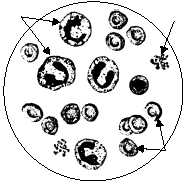evaporation does not remove all the sweat that has been
excreted, the sweat collects in beads on the surface of
the skin.
CERUMINOUS GLANDS.—Ceruminous
glands are modified sweat glands found only in the
auditory canal. They secrete a yellow, waxy substance
called cerumen that protects the eardrum.
THE CIRCULATORY SYSTEM
LEARNING OBJECTIVE: Identify the parts
of the circulatory system, and recognize their
major components and functions.
The circulatory system, also called the vascular
system, consists of blood, heart, and blood vessels.
The circulatory system is close circuited (i.e., there is
no opening to external environment of the body). The
function of this system is to move blood between the
cells and the organs of the integumentary, digestive,
respiratory, and urinary system that communicate with
the external environment of the body. This function is
facilitated by the heart pumping blood through blood
vessels. The blood travels throughout the body
transporting nutrients and wastes, and permitting the
exchange of gases (carbon dioxide and oxygen).
BLOOD
Blood is fluid tissue composed of formed elements
(i.e., cells) suspended in plasma. It is pumped by the
heart through arteries, capillaries, and veins to all parts
of the body. Total blood volume of the average adult is
5 to 6 liters.
Plasma
Plasma is the liquid part of blood (fig. 1-31).
Plasma constitutes 55 percent of whole blood (plasma
and cells). It is a clear, slightly alkaline, straw-colored
liquid consisting of about 92 percent water. The
remainder is made up mainly of proteins. One of these
proteins, fibrinogen, contributes to coagulation.
Blood Cells
The blood cells suspended in the plasma constitute
45 percent of whole blood. Its cells, which are formed
mostly in red bone marrow, include red blood cells
(RBCs) and white blood cells (WBCs). The blood also
contains cellular fragments called blood platelets.
When blood components are separated, the WBCs and
platelets form a thin layer, called the buffy coat,
between the layers of plasma and RBCs. These layers
are illustrated in figure 1-31.
RED BLOOD CELLS.—Red blood cells, or
erythrocytes, are small, biconcave, nonnucleated
disks, formed in the red bone marrow (fig. 1-32).
Blood of the average man contains 5 million red cells
per cubic millimeter. Women have fewer red cells, 4.5
million per cubic millimeter. Emotional stress,
strenuous exercise, high altitudes, and some diseases
may cause an increase in the number of RBCs.
During the development of the red blood cell, a
substance called hemoglobin is combined with it.
Hemoglobin is the key of the red cell's ability to carry
oxygen and carbon dioxide. Thus, the main function of
erythrocytes is the transportation of respiratory gases.
The red cells deliver oxygen to the body tissues,
holding some oxygen in reserve for an emergency.
Carbon dioxide is picked up by the same cells and
discharged via the lungs.
The color of the red blood cell is determined by the
hemoglobin content. Bright red (arterial) blood is due
to the combination of oxygen and hemoglobin. Dark
1-24
BLOOD
SAMPLE
LIQUID
(PLASMA)
"BUFFY
COAT"
RED BLOOD
CELLS
55%
45%
HM3F0131
Figure 1-31.—Blood sample illustrating blood components.
HM3F0132
PLATELETS
WHITE
BLOOD
CELLS
RED
BLOOD
CELLS
PERIPHERAL BLOOD SMEAR
Figure 1-32.—A blood smear showing red blood cells, white
blood cells, and platelets.




